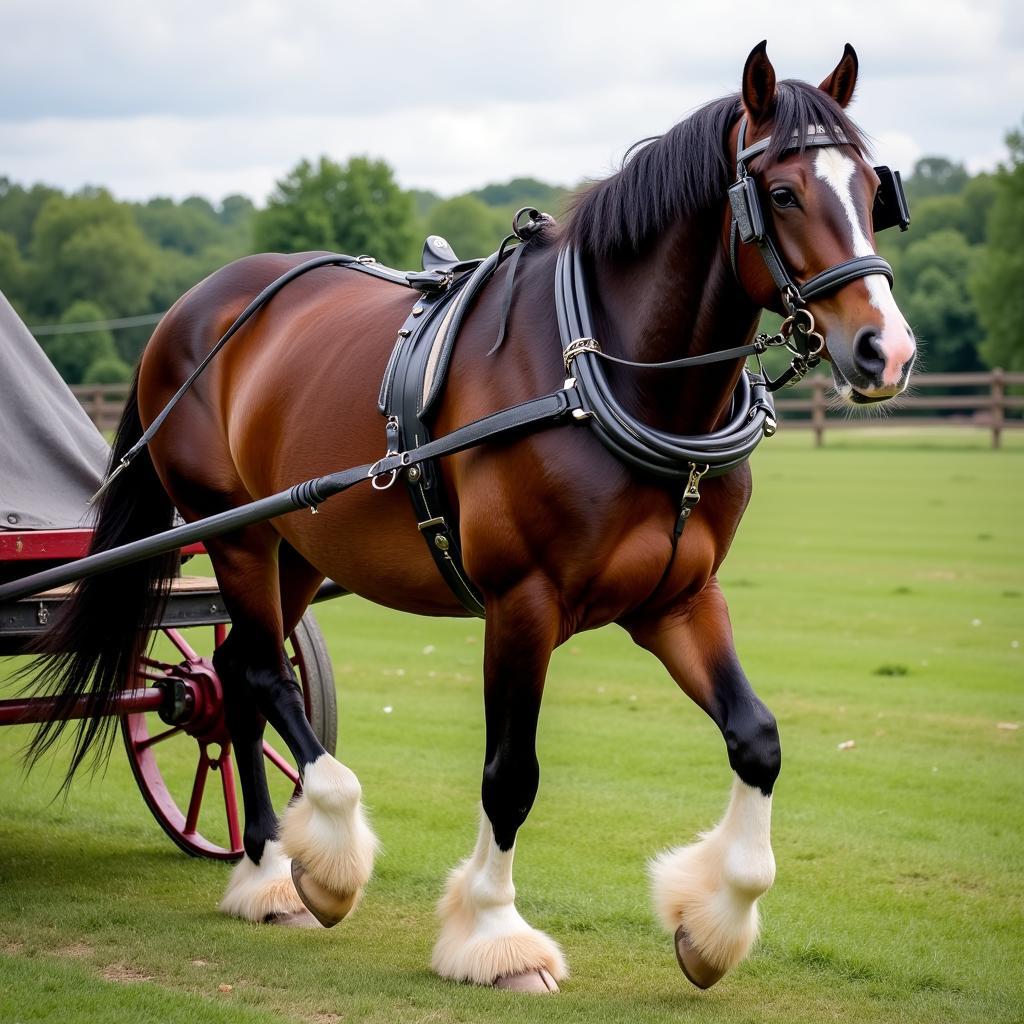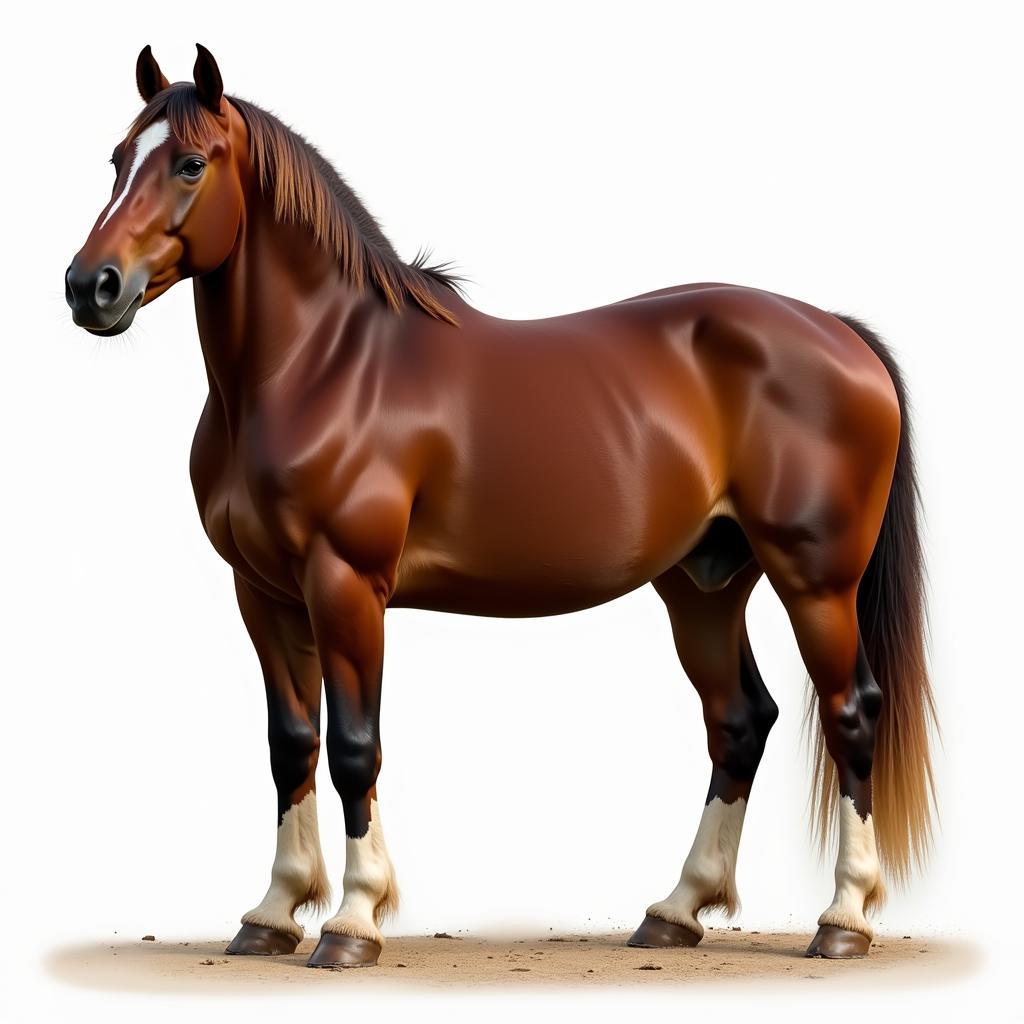Work Horse Construction, in the context of equine care, refers to the overall build and conformation of a horse bred for strength and stamina. These horses, often referred to as “draft” breeds, are characterized by their powerful musculature, heavy bone structure, and calm temperaments. This article will delve into the specific physical attributes that contribute to a work horse’s remarkable ability to perform demanding tasks.
What Defines Work Horse Construction?
Unlike lighter riding breeds, work horses are built for power over speed. Their conformation, which refers to the skeletal and muscular structure, reflects this primary function. Let’s break down the key elements:
1. Powerful Shoulders and Chest
 Work Horse Shoulders
Work Horse Shoulders
A work horse’s strength originates from its massive shoulders and deep chest. The shoulder blades are long and sloping, allowing for a wide range of motion and powerful strides. This design facilitates efficient energy transfer from the legs to the load being pulled. The broad chest accommodates a large heart and lungs, essential for endurance.
2. Strong, Straight Legs
Work horses possess thick, sturdy legs with large joints to withstand the stress of pulling heavy loads. Short cannon bones – the area between the knee and fetlock – provide leverage and reduce strain on tendons and ligaments. Correct leg conformation is crucial to ensure soundness and longevity in a working animal.
3. Large, Durable Hooves
Large, round hooves with thick walls are a hallmark of work horse construction. These hooves provide a wide weight-bearing surface, distributing the horse’s mass and the weight of the load evenly. This is essential for preventing lameness and maintaining good hoof health, especially on hard or uneven terrain.
4. Short Back and Strong Coupling
 Powerfully Built Work Horse
Powerfully Built Work Horse
A short, strong back with well-defined musculature is vital for transferring power from the hindquarters to the shoulders and ultimately to the load. The “coupling” – the area between the last rib and the croup – should be short and strong, indicating a powerful connection between the horse’s engine (hindquarters) and its transmission (back and shoulders).
5. Calm Temperament
While not a physical attribute, temperament is a crucial consideration in work horse construction. Breeds like Clydesdales, Shires, and Belgians are renowned for their calm, willing dispositions. This inherent docility makes them safer and more reliable partners for handling heavy equipment and navigating challenging situations.
The Importance of Sound Conformation
Sound conformation in a work horse is paramount for its well-being and ability to perform its intended tasks. Proper structure ensures efficient movement, reduces the risk of injury, and promotes longevity.
Just as a poorly constructed building is prone to collapse, a horse with conformational flaws is more susceptible to lameness and other health issues. For example, horses with long pasterns may experience strain on their tendons, while those with narrow chests might have difficulty breathing deeply during strenuous work.
Buying a Work Horse: What to Look For
If you’re in the market for a horse drawn bobsled for sale and need the right horse to pull it, understanding work horse construction is key to making a wise investment. When evaluating a potential work horse, consider the following:
- Overall Balance: Does the horse appear well-proportioned, with its body parts fitting together harmoniously?
- Movement: Does the horse move freely and effortlessly at a walk and trot? Are the legs straight and true, without any signs of interference or uneven wear on the hooves?
- Temperament: Is the horse calm, responsive to handling, and willing to cooperate?
Always consult with a veterinarian or experienced equine professional to assess a horse’s conformation and overall health before making a purchase.
Conclusion
Work horse construction is a testament to the incredible strength and endurance of these magnificent animals. By understanding the key elements of their build – from their powerful shoulders to their large hooves – we gain a deeper appreciation for their ability to perform demanding tasks.
Whether you’re looking for a horse to pull a plow, haul logs, or provide a nostalgic touch to your farm, choosing a horse with sound conformation is essential. By prioritizing the well-being of these hardworking animals, we ensure their longevity and ability to continue their legacy of strength and service.
FAQs About Work Horse Construction
1. What is the ideal height for a work horse?
While height can vary between breeds, most work horses stand between 16 and 19 hands high (64-76 inches) at the withers.
2. How much weight can a work horse pull?
The pulling power of a work horse depends on factors like breed, training, and individual strength. On average, they can pull up to 8,000 pounds, or three to four times their body weight.
3. Are work horses suitable for riding?
While some work horses are trained for riding, their size and gaits make them more challenging for beginners. It’s important to choose a horse that has been specifically trained for riding and is well-suited to the rider’s experience level.
4. What is the average lifespan of a work horse?
With proper care, work horses can live well into their 20s. Providing a balanced diet, regular exercise, and routine veterinary care is essential for their longevity.
5. How do I find a reputable breeder or seller of work horses?
Seek recommendations from experienced horse owners, attend local horse shows and events, and thoroughly research any potential breeder or seller. Ask for references and inquire about the horse’s history, health records, and training.
Need help deciding what type of work horse is right for you? Check out our article on ideas for horse costume class for inspiration!
Have more questions?
Contact us today! Our team of experts is available 24/7 to assist you with all your equine needs. Call us at 0772127271, email us at [email protected], or visit us at QGM2+WX2, Vị Trung, Vị Thuỷ, Hậu Giang, Việt Nam.